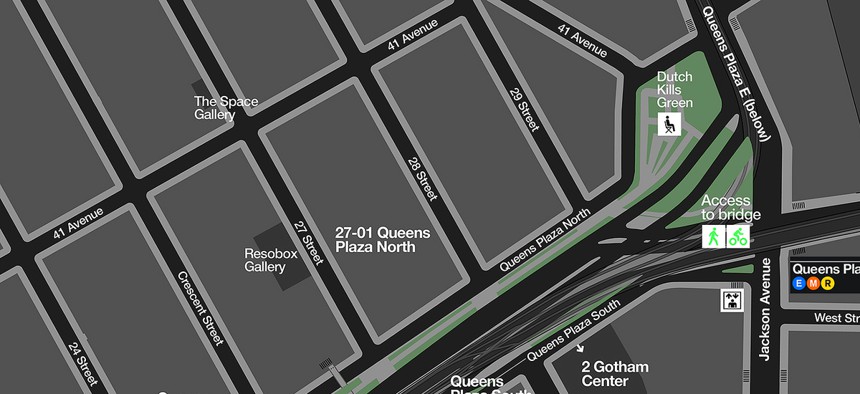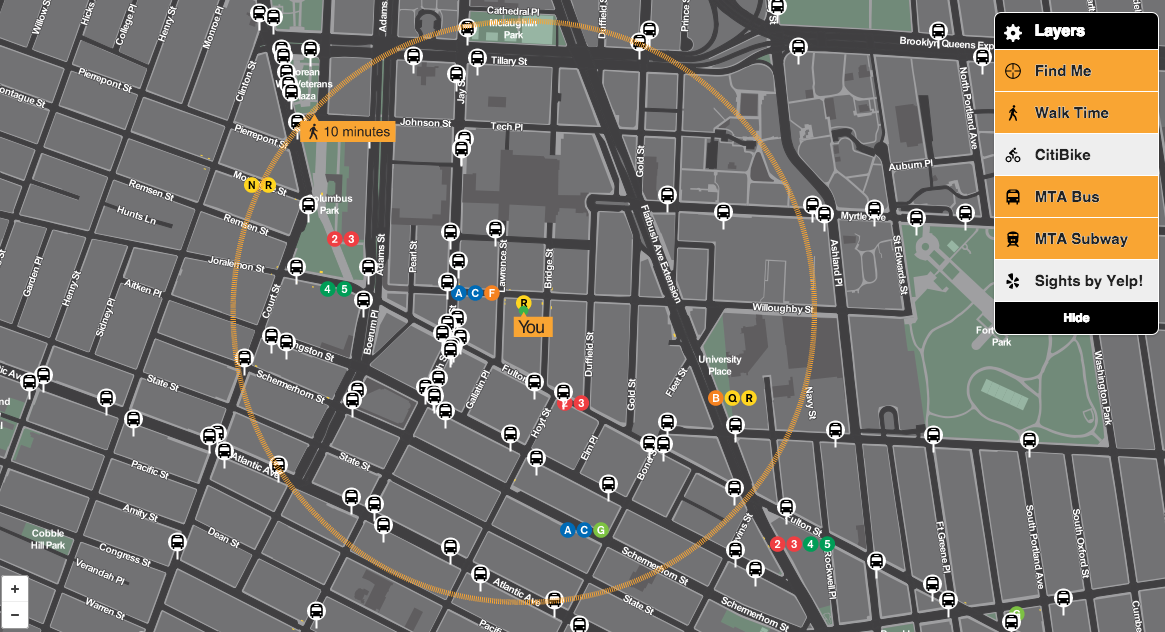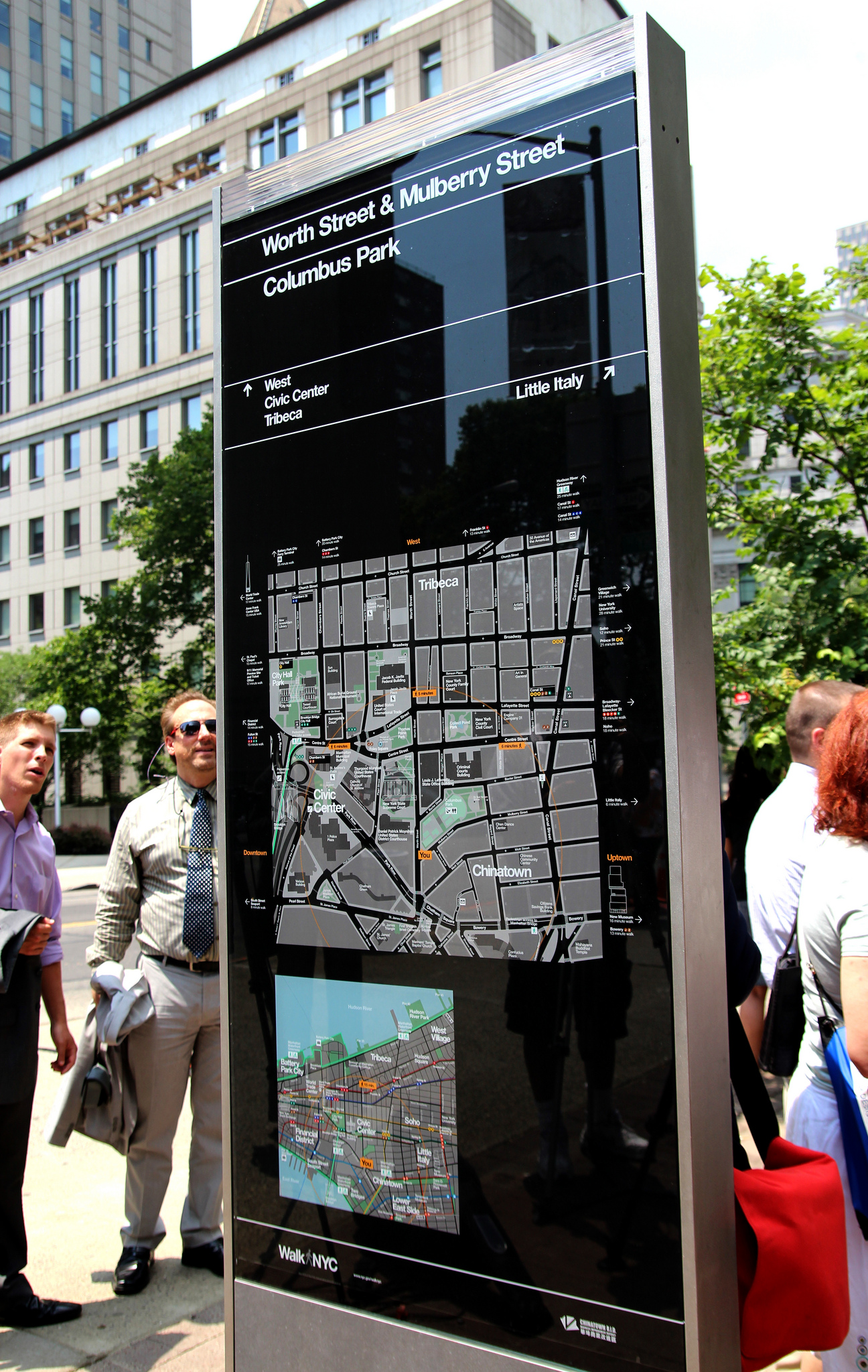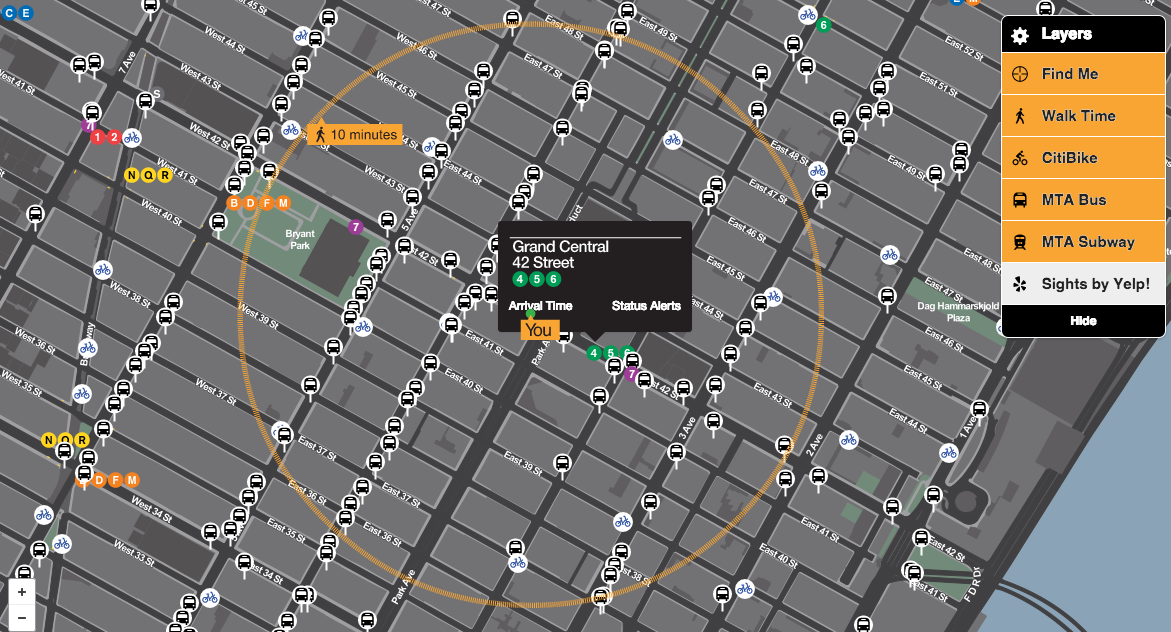How New York City Is Becoming Even More Map-Centric With Its Data

New York City has made a major investment in physical and digital wayfinding. NYC Department of Transportation
The city’s transportation CTO details how to create valuable tools for the public, put everything on a map and not reinvent the wheel in the process.
The availability of real-time transportation information can take some of the guess work out of getting from Point A to Point B.
That’s especially true in New York City where complex layers of transportation infrastructure, including the extensive subway and bus systems and the growing bikeshare network, present plenty of options for those who rely on public transit to get around the nation’s largest city everyday.
As part of its efforts to make more data available online, New York City’s Department of Transportation created a mobile-friendly HTML 5 application that puts all that puts all that transportation information, including when the next train or bus will arrive, in one spot—and all on one map.

“The overall idea is that we want people to be able make the most-informed decisions about their transportation options and that online app is one way to do it,” Cordell Schachter, the chief technology officer for the city’s DOT, said in a recent interview.
The first version of that app, iRideNYC, was released a year ago and built in-house for roughly $50,000. The next version will be available later this fall. Pulling all the necessary data wasn’t exactly a simple walk through the park since the city’s DOT doesn’t actually control the subways and buses—New York state’s Metropolitan Transportation Authority does.
But Schachter’s agency didn’t have to reinvent the wheel to make it all work, either.
The NYCDOT took advantage of scalable cloud technology services from Amazon Web Services, which this summer named the agency as one of eight winners of the first-ever City on a Cloud Innovation Challenge.
GovExec State & Local recently interviewed Schachter about what it took to create iRideNYC, what’s next for the app and other data-driven projects the city’s transportation agency is working on.

GovExec State & Local: Tell me about how iRideNYC works and how the New York City Department of Transportation put it together.
Cordell Schachter: The iRideNYC web app collates information from subways and buses and even our own CitiBikes into a single responsive app that will find you if you’re accessing it from an iPhone or an Android phone and present you with a menu to not only see where the nearest subway stations or bus stops are but also, actually, when the next subway or bus will arrive.
So before you commit to one mode or another, you have the data you need to make a decision. It even has a little radius tool that resizes itself as you zoom in or zoom out of the map to show you how far it is to walk to your destination. We put that together in collaboration with the [Metropolitan Transportation Authority] and our in-house developers.
The overall idea is that we want people to be able make the most-informed decisions about their transportation options and that online app is one way to do it.
The app’s delivery also showcases our intent to right-source and right-size what it is we do whether it’s commercial or open source or whether it’s something in our environment or in the cloud. And each time we’re going to deal with a problem or we’re going to re-engineer or modernize a legacy application, we make decisions about what it should be and whether we have the technology to support it.
One of the most important factors when we’re dealing with a public-facing app, like this iRideNYC app, is that we would really like a commercial cloud provider to handle the security and, for instance, stay up all night worrying about a denial-of-service attack, so we can concentrate on our core mission.
GovExec State & Local: How long did it take to pull that all together, including the testing phase and public release?
Schachter: The initial version took about six months. We were able to reuse code base that we had started for other applications. And that’s one of our right-sourcing strategies. We try to never to reinvent the wheel. If we can borrow something or modify something that we’ve created, we’re going to try to do that as opposed to starting from scratch.
GovExec State & Local: What were the major of the data sources you needed to pull together to make the application work?
Schachter: We needed real-time performance information for each transportation mode. Buses and subways are both run by New York state's Metropolitan Transportation Authority, and they had already published developer-friendly transit information feeds. They have apps for bus-arrival times and a separate portal for subway information. They don’t have a single app for both modes. Their BusTime app uses texts to provide arrival-time information. Our goal was to put transit performance information about all of the modes available at a particular location in the palm of a customer’s hand in a single app.

An example of a Walk NYC sign in Lower Manhattan (Photo courtesy NYCDOT)
We also have [the WalkNYC] wayfinding project—maybe you’ve seen that around the city.
With the wayfinding project, that came from the desire to put all the available information in one place with some of the look and feel of that printed physical map that’s adapted to have a digital component. We did some marketplace surveys to find out whether we were going to do it ourselves or have it developed for us. What we found out is that we could save millions of dollars doing it in-house.
GovExec State & Local: What’s next for the iRideNYC app?
Schachter: Version two will be out this fall. It will include a major change to the menuing. Right now, with the menu, if exposed, you have to hide it manually. We want people to be able to choose multiple layers and we couldn’t predict how many layers users would want. The menu doesn’t auto disappear.
We’re moving to—and it’s becoming a standard—where the the menu is exposed on the main screen by sliding to one side. So you’ll see that in the fall.
You’ll also notice that we have a Yelp integration. One of the layers is for Yelp features. That was done as a proof of concept to show that we can integrate third-party data. What we would like to see is us working with New York City’s tourist organizations . . . as well as other smaller organizations in the city.
If they’re going to have a convention or a conference in the city, they could produce a custom layer showing their hotels and meeting spaces. You wouldn’t go to the iRideNYC website, but you’d point your clients to a subsite where you would get all of the general transit information plus your custom overlay.

GovExec State & Local: Sometimes it’s difficult comparing New York City, with its complex layers of infrastructure, with other cities. But looking at iRideNYC, it seems like it has some pretty common elements that most cities could adapt for their own mobility needs. What could other cities learn from your experience building this?
Schachter: One, you want to stick to your expertise. There was no reason for us to create our own transit feeds. We were better off getting that information from the MTA.
Secondly, for transportation agencies, you really need to be map-centric. Everything we do has to be on map.
When you go to a lot of our websites right now, they are still heavily text centric. The tools and technology exist to have everything map-centric and the projects that we’ve done on this code base that iRideNYC uses puts maps front and center.
And we’re big believers in mobile first. We continue to develop our work on small screens and make design decisions that are needed to make it functional on that small screen. . . . When you put all your time and effort into designing elements for a large screen, it’s sometimes impossible to rewrite it for mobile.
The third is to really evaluate what your options are in terms of the software and security and rethink it each time, even if it’s briefly, for your new use. Where’s the best place to do this? What’s the best software to use? And if possible, reuse what you already have.
GovExec State & Local: Earlier you spoke about why it was important to have cloud infrastructure for overall support. How important is to have cloud infrastructure? Why was that was an important move?
Schachter: As interested as we are with security in New York City . . . we’re just not going to have the kind of experience that a major cloud provider will have. Nor will we have the layers of resources that they’ll have. And we won’t be able to make the kind of investment that they can make to keep their customers and sites safe.
The cloud is also an important factor for improving the city’s resiliency. We did pretty well with Hurricane Sandy. But we need to do better.
DOT hosts its own email. We still host it and we had plenty notice with Sandy and we were able to move it over to our disaster recovery site. But we didn’t have enough there to focus on the response that the public needed, particularly the response to adjust our method of operating given our [post-storm] reality of where we had facilities and where we didn’t.
The idea that your hosting environment—like the one for your apps—is virtual and can be hosted by a provider at a number of different data centers adds a real strategic advantage.
GovExec State & Local: Are there any unique opportunities or collaborative challenges when you’re dealing with a state agency like the MTA and a city agency like yours? Obviously, you have a similar mission but the governance structure is different and there may be different ways of doing things.
Schachter: We had to establish the information that we needed at the time and, basically, if we had to add a task, it might have taken longer for them to do and require various levels of approval. Because the [MTA’s] transit feeds were already published, it made it a lot easier for us.Interacting with another government organization is sometimes no more difficult than dealing with a division within your own agency. People are focused on their core mission. So when you come to them from outside their core mission, no one ever has all the resources that they need. So they have to prioritize.
Something that we need to do—especially on the development side—when making services available to the public is establishing and improving the value that’s created for the public by these new innovative projects. . .
It can be easier to defend why you should do something in a private company because you’re going to make more money this way than the previous way. In the government we always have to produce value.
I think we have to be really focused on value and I think by doing that even when you green-light projects, [proving that you will produce value] will go a long way in preventing runaway projects. If it’s no longer going to create value at a certain cost, as painful as it is, shut the project down. If you know what that feeling is to begin with, it adds a layer of discipline to everyone’s work.

Mayor Bill de Blasio (Photo courtesy of the NYC Mayor's Office)
GovExec State & Local: Mayor Bill de Blasio recently signed council legislation that impacts the digital mechanics of how the City Register is published online. Overall, New York has been a leader on open data. How are some of these recent initiatives impacting your work at the New York City DOT?
Schachter: I find that one of the groups I collaborate with a lot within DOT is our legal division, which is responsible for all our [Freedom of Information Law] requests and any discovery requests that come with litigation. DOT is one of the most heavily sued governmental entities in New York City. As you can imagine—with people falling off of curbs or getting into some sort of car accident, etc.—very often there is litigation with the city for the responsibility of those accidents.
We’re constantly producing volumes of information. We’re asked to be more efficient and asked to produce more. Also, the size of our data store keeps increasing and that makes searches more time consuming. We help ourselves and the public by putting more information online so the public can access it directly.
The city’s goal as a whole is to have all the eligible data sets published by 2018. We’re looking at getting data published as quickly as possible because we think it will help us.
In fact, when Mayor de Blasio was the Public Advocate, he rated the city’s agencies in terms of timeliness and responsiveness to [Freedom of Information Law] requests. DOT was one of the two agencies that got an A — highly rated.
So we take that seriously. With the management of our information infrastructure, we in IT share that with legal. So we have a legal division that’s very sensitive and knowledgeable about IT capabilities and the IT staff members I’m responsible for are very sensitive to legal’s need to be responsive to courts and litigants.
GovExec State & Local: Is there anything you want to add about the iRideNYC app?
Schachter: We’re very excited about the reception the application has received. And it really shows that our government employees don’t take a back seat to anyone. We have a creative and diverse staff with people who are committed to the government’s mission. I feel that the people we have stand shoulder to shoulder with the best developers in the industry.
On the data side, we see members of the public as our collaborators. . . About two years ago, we were responding to a local law that said that we had to publish our parking regulations online on a map.
We had to take a legacy, text-based data store and make all that information available so you could click on a street on the map and find those parking regulations.
So the first step for us was to have have a text-based search tool—what street you were interested in, what stretch started where and where it ended, the borough you were in, etc. You type all that in and can get all the regulations for that one block.
A developer called me and said: “I want to start a business selling parking information for local restaurants” so can they tell their patrons about it. Basically, they’re collecting public information. There’s a great little business case right there.
He said: “I’m sitting here crossing off street after street in Manhattan and I’ve been doing it for eight hours. I’m getting cramps in my hands. And I know you guys have to have this information in some sort of a file. What’s it going to take for you to release that file?”
We were just getting started on this open-data path and I said: “How about if we post it next month?” And he goes, “Well … wait did you say next month?”
“Actually, yeah.”
He was expecting an argument from me. He was ready with all these justifications about why it needed to be done and needed to be a priority.
It really just took us understanding that somebody was going to use it and use it right away for us to be able to prioritize that over areas that we were working on.
And since that point, we created essentially, two spreadsheets, two CSV files, side by side. You combine them and you have the keys to the whole kingdom.
Since that time, we published the map for parking regulations. If you search for “NYC parking regulations” online, it’ll take you to a map with a little stylized icon with every regulation that you can click on. It will bring it up for you within map.
Or if you’re a developer or someone who is more sophisticated technologically, you can actually get these files and do it for yourself. We really want to go where the public needs us to be. And we want to really want to release the information that they paid for in the most effective way.
And that strategy really combines both our in-house development systems and data systems as well as working with partners both with development and with the cloud.
NEXT STORY: The Roller-Coaster Economies of Vacation Towns






